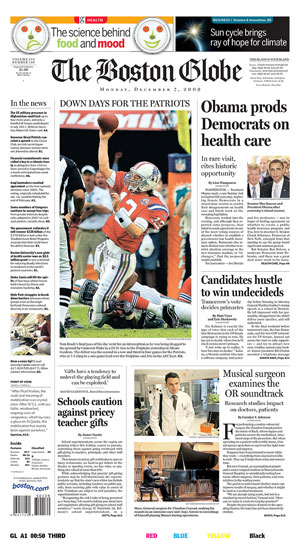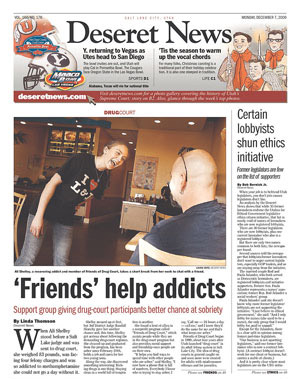The Fabulous Papers
Journalism is dying, journalism is thriving, the end of the world is nigh—there’s a lot to be excited about. A report on the newspapers that prevailed by hook or crook in 2009.
Until a few years ago I almost never opened a newspaper, save to read Dear Abby or draw moustaches on those pictured in the wedding announcements.
But then one thing lead to another and I ended up in journalism school, where I’m perpetually atoning for the sins of my past. Every day is Newspaper Kippur; I wake early to pray at my altar to Ben Bradlee, placing steno pads and packs of Lucky Strikes at his feet. I fast until nightfall, when I order a carton of cut-rate lo mein that I eat at my dingy desk. At midnight I retreat to my study to pore over newspapers like a Talmudic scholar.
This year, I want to pay homage to what I’ve seen—the papers that too often go unrecognized by the Pulitzer Prize committee, Romenesko, Gawker, and you. These are the papers that defy boundaries, the internet, and, oft times, common reason. Some are cellulose-based, or not; the medium is no longer the message. But one thing’s for certain: These papers mattered in 2009, and through a combination of gumption, gusto, and hard-headed lunacy, they prevailed.
Talk of the Town
Daily Talk editor Alfred Sirleaf does not have an expense account. His bare-bones paper is as populist as populist gets. It runs out of a hut and stays afloat through donations of pre-paid cell phone cards and cash. Unlike other Liberian newspapers, the Talk eschews overwrought prose and uses symbols to communicate with illiterate but wanting news consumers—a kerosene lamp and fluorescent light bulb can denote an electricity story, a bag of liquid for one about drinking water.
Over time, Sirleaf has gained both a loyal following and his share of street cred; former Liberian president Charles Taylor drove him into exile several years ago for his criticism of the government. In a testament to his operation’s power, Sirleaf eventually returned to his shack and estimated 10,000 readers while Taylor was forced out of office and is on trial for war crimes at The Hague. Chalk it up to a win for old media.
In Really, Really Cold Blood
Bozeman, Mont., is a bucolic town of 27,000, used as the setting for films like The Horse Whisperer and A River Runs Through It. Beside the occasional visit from Robert Redford and some fairly tense high school wrestling matches, not much happens there.
But the Bozeman Daily Chronicle does not sit back and let nefarious occurrences go unreported. When something resembling criminal activity in Bozeman occurs, it covers it, stating the facts without fanfare, though with perhaps an eye for the absurd and some tongue plugged in cheek. Some recent examples:
Nov. 29, 2009: An officer spoke with someone who was interested in seeing “what it felt like” to be hit with a Taser.
Nov. 30, 2009: Someone called to report a buck that had baling twine in its antlers, stating they thought someone should know about it.
Dec. 3, 2009: A young male entered a closed business on North 19th Avenue and tried to steal beer. When confronted, he dropped the beer and ran.
Dec. 4, 2009: Someone dumped a couch in an alley on South Grand Avenue.
Indeed, the need for civic tranquility never sleeps. Savvy as they are moral, the police reports are on Twitter.

Netflix Killer
The New York Times’s beleaguered cousin could be renamed The Paper That Would Not Die Even As Arthur Sulzberger Tried To Go All Kevorkian On It. Threat of closure prompted the Boston Globe’s loyal fanbase of at least 12 congressmen—the late Ted Kennedy included—to send a letter to Sulzberger in April, imploring him not to pull the plug on a newsroom that produces such gems as a graphic feature to illustrate how C.I.A. agents communicate with each other by rubbing the backs of their necks.
In general, the Globe maintains one of the most visually dynamic products on the web. Its hyper-developed photography section tells stories aimed at pacifying HDTV-lovers and picture nerds alike—I found their slideshows so placating that I cancelled my Netflix subscription. Notable recent galleries include: The world’s largest cruise ships; the indigenous people of Borneo; inside the Large Hadron Collider. Go full-screen for a sensory journalistic experience.
Wild Horses, Wolves, and Fathers
The tiny but hardy Santa Fe Reporter covers two things very well: Wild animals and domestic violence. One recent cover story zeroed in on a recession-related superfluity of abandoned mustangs; another on spousal abuse among wealthy, elderly couples. Mere weeks earlier, there were articles on the reintroduction of wolves to the wild and the lack of protection area police provide abused women. All of these stories were at once urgent and serious—and as unique to Santa Fe as turquoise bracelets and green chile burgers.
The paper can also boast one of the country’s most non-sequitur parenting columns, titled “Daddy Needs a Drink,” in which Daddy, also known as the preternaturally well-coiffed Rob Wilder, ponders buying a trampoline, his son’s mullock (mullet-dreadlock), and, yes, booze, which in a recent entry came in the form of him alone in a New York City bar, sipping on a drink called the Jane Fonda.
Nichie Niche
Based in Miami, KYC (“Know Your Customer”) News is the go-to publication for those intrigued by banks operated out of French taverns in Monserrat and Bermuda’s bustling business sector. The site trumpets due diligence in an arena underscored by ethical cacophony—even though it claims to have known about mini-Madoff Allen Stanford for 10 years before the Feds unearthed his $8 billion Ponzi scheme last February. Oops.
But lest you be doubtful about KYC’s credibility, it cites a full run-down of other papers that have used its reports, ranging from Grenada Today to the Wall Street Journal. Their references fail to extend past 2006, but it’s probably just because they’re too entrenched in current offshore fraud coverage to update the page.

New Media Meets Mormonism
“Deseret” is a Mormon term meaning both honeybee and the area Utah composes; the Deseret Morning News covers both. Since 1850, it has held the Latter-day Saints community in a headlock with stories on nuns running the Boston Marathon and Brigham Young’s buttermilk donuts. But most compelling is its feature called the “Bloggernaccle,” which aggregates the best posts and links from the effervescent Mormon blogosphere. (Apparently, to blog as a Mormon is to answer a call from God, thus the bloggernaccle is teeming with consecrated bloviators.)
But the bloggernaccle isn’t all holy theory. There’s fun stuff—“Twilight” coverage and a link to a Mormon version of “The Chanukah Song”—and practical advice on how to be the best Morman you can be. For instance, it endorses the Zig Millenium pen (“doesn’t the name just strike you as wonderfully Mormon?”) as the premier implement with which to mark scriptures.
Austere to the Finnish
It’s difficult to understand the notoriously sober Finnish, but the Helsinki Times, Finland’s only English newspaper, ever-so-slightly pulls back the veil that shrouds the country’s people. The paper, pioneered by director-producer-writer-documentary filmmaker Alexis Kouros—best known for his film Waiting for Godot at DeGaulle, on which the Spielberg-helmed epic The Terminal was based—is in itself airport-esque, cleanly designed in shades of blue and gray and with straightforward categories: “Culture. Business. T.V. Column.” Its scope of coverage ranges from the banal (one recent headline read “Bills Cost Money”) to the sensational, with reporting on the military-style gangs that comprise the Finnish underworld.
A weekly series on life in Finland, however, offers a poignant look into the country’s culture. In one column, a writer explores her discomfort at expressing enthusiasm at the end of a theater performance—too bawdy!—and considers the best way to acknowledge a job well done. She ultimately pledges to “clap quietly yet enthusiastically, but not fill space with words to escape the discomfort of a long pause between sentences or an awkward moment.” Sage advice.

The New York Worst
The New York Post, America’s longest-surviving daily, deserves a thorny crown of laurels for attempting to maintain an old-fashioned newsroom—albeit in a racist, misogynistic sense. There’s the Obama-as-a-chimp cartoon from February, fat-hating columnist Andrea Peyser, and a recent lawsuit filed by a former staffer that alleges the paper’s editor, Australian expat Col Allan, delighted in rubbing his groin against female employees and showing them pictures of penises on his BlackBerry.
This might not explicitly justify why the Post’s circulation fell 30 percent this year, but any semi-informed news consumer can connect the dots.
Paradise of Information
It wasn’t long ago that one could hardly enjoy Al Jazeera’s English-language website because of two inhibitive words: Real Player. But all that’s history now that the news outlet has transitioned content to its own YouTube channel, making Middle Eastern news much easier to lose oneself in. And beyond inaugurating itself into the 21st century, Al Jazeera’s website also underwent an extreme makeover. No longer is the site dated and clunky—the new aesthetic puts forth a quilt of articles encased in gold-toned boxes, presenting a veritable paradise of information.
Because websites are not just about looks, quintessential hard-hitting Al Jazeeran stories run deep under the site’s revamped facade: about the Peruvian gang that killed people to sell their fat to European cosmetics companies (later reported to be a hoax), cash-raking Russian DJs, and the Dalai Lama’s travel plans. But there’s also a live blog of the Hajj, with videos that make you feel as if you are there—on the road to new media’s bright, complicated, choral future.
